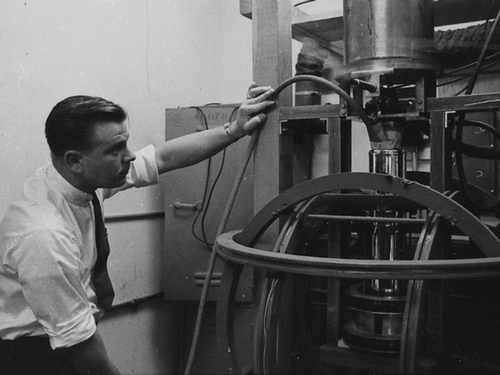Landmarks—Superconductor Quantizes Magnetic Field
Landmarks articles feature important papers from the archives of the Physical Review journals.
Two experiments reported in 1961 showed that the magnetic field passing through a hollow superconducting cylinder is quantized, meaning that it can exist only in certain discrete amounts, multiples of a universal magnetic flux unit. The discovery confirmed a prediction made a decade earlier except that the flux unit was half what the earlier argument said it should be. That difference, further theoretical analysis showed, firmly established the idea that superconducting electrons work in pairs.
In a book published in 1950, before any satisfactory theory of superconductivity existed, Fritz London of Duke University in North Carolina offered a simple argument for the quantization of magnetic flux passing through a superconducting loop. If current-carrying electrons in the superconductor were described by a quantum wave function that ran continuously around the loop, the wave function had to be periodic—each time around the loop it had to take on the same values. This restriction, London found, meant that the magnetic field induced by the superconducting current in the interior of the loop would be quantized. He predicted that the smallest possible magnetic flux—the universal unit—would be Planck’s constant times the speed of light, divided by the charge of the electron: [1].
In the late 1950s, graduate student Bascom Deaver worked with William Fairbank at Stanford University in California to test this prediction. To make a superconducting ring, Deaver electroplated a thin layer of tin onto a copper wire. Deaver and Fairbank tested two different tin cylinders, each about one centimeter long, with an internal diameter of just over 10 micrometers.
Placed in a magnetic field and cooled in liquid helium to less than 3.7 degrees Kelvin, the tin became superconducting. The researchers then turned off the magnetic field. To measure any magnetic flux that remained trapped within the cylinder, they vibrated it back and forth at 100 hertz and measured the electrical signal generated in nearby coils of wire. They found that the flux through the cylinder increased in a stepwise fashion with increasing strength of the original applied field. The height of each step, however, was half the flux unit that London had predicted.
Unknown to Deaver and Fairbank, two researchers in Germany had completed a similar experiment, yielding the same result, and had also submitted their work to Physical Review Letters. Robert Doll and Martin Näbauer of the Bavarian Academy of Sciences' Commission for Low Temperature Research in Herrsching made a tiny superconducting cylinder by depositing lead on a quartz fiber. They measured the trapped magnetic flux by suspending the cylinder on a thread and causing it to twist back and forth in an oscillating magnetic field of known strength. “Their data was a little sharper,” says Deaver, now an emeritus professor at the University of Virginia, Charlottesville, but both experiments convincingly demonstrated flux quantization.
Deaver says that as their experiments were in progress, Fairbank asked a number of theorists for their predictions of the results. Only Lars Onsager of Yale University came up with the correct answer. He said that if the current in a superconductor was carried by pairs of electrons, London’s flux quantum should be based on twice the electron charge, , making the flux quantum . The role of electron pairing, suspected for some time, had been confirmed in 1957 in the Bardeen-Cooper-Schrieffer (BCS) theory of superconductivity [see Focus Landmark—Superconductivity Explained]. However, pairing was still a novel idea, and theorists were continuing to work out its implications.
At Stanford, meanwhile, Deaver and Fairbank talked to local theorist Nina Byers as well as C.-N. Yang, who was visiting from Princeton University. In a more sophisticated version of London’s argument, Byers and Yang derived the crucial factor of 2 and then showed that it also amounted to a confirmation of electron pairing. Onsager wrote a short note to the same effect, and the two theoretical analyses appeared in the same issue of Physical Review Letters, sandwiched between the two experimental papers [2, 3].
Philip W. Anderson of Princeton University says Onsager’s paper didn’t mention BCS and “perversely” ascribed electron pairing to an earlier theory. Nevertheless, he says, “most of those who were thinking about BCS immediately accepted” the connection between the new experimental results and electron pairing in BCS.
This research was published in Physical Review Letters.
–David Lindley
David Lindley is a freelance science writer in Alexandria, Virginia.
References
- F. London, Superfluids, Macroscopic Theory of Superconductivity, Structure of Matter Vol. 1 (Wiley, New York, 1950), p. 152[Amazon][WorldCat].
- B. S. Deaver and W. M. Fairbank, “Experimental Evidence for Quantized Flux in Superconducting Cylinders,” Phys. Rev. Lett. 7, 43 (1961).
- L. Onsager, “Magnetic Flux Through a Superconducting Ring,” Phys. Rev. Lett. 7, 50 (1961).





